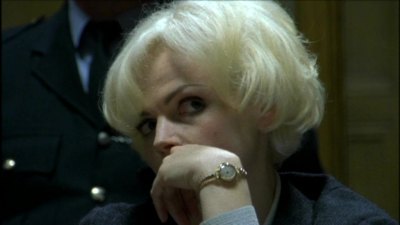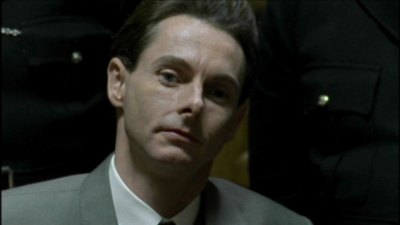| Reviews & Columns |
|
Reviews DVD TV on DVD Blu-ray 4K UHD International DVDs In Theaters Reviews by Studio Video Games Features Collector Series DVDs Easter Egg Database Interviews DVD Talk Radio Feature Articles Columns Anime Talk DVD Savant Horror DVDs The M.O.D. Squad Art House HD Talk Silent DVD
|
DVD Talk Forum |
|
|
| Resources |
|
DVD Price Search Customer Service #'s RCE Info Links |
|
Columns
|
|
|
See No Evil: The Story of The Moors Murders
Between 1963 and 1965, in the greater Manchester region around southeast Lancashire and west Yorkshire of England, serial killers Ian Brady and Myra Hindley kidnapped, raped, and brutally murdered two teenagers and three young children in one of England's most sensational, horrifying crime sprees. The case made worldwide headlines (many labeled it at the time as Britain's "crime of the century"), and to this day, the mention of these two savage murderers still evokes the kind of disgust and hatred from the British public reserved for the most despicable of criminals.

Unfortunately, the 2006 ITV docudrama based on these terrifying crimes and their perpetrators, See No Evil: The Story of the Moors Murders, is a flat, largely desultory and un-involving recreation of the facts that fails to adequately explore either the killers' motivations, or to properly put the heinousness of their crimes in perspective. Evidently, this TV miniseries - the first such adaptation of this notorious case nearly forty years after the events - was made on the condition of ensuring the full cooperation of the victims' families. Whether this carefulness not to offend those still-grieving victims influenced the filmmakers to "go easy" on the subject matter, or rather that the film was compromised from the start by focusing more on the marital relationship between Maureen Smith (Myra Hindley's sister) and David Smith (a witness to the final murder) rather than on the killers and their crimes, it's hard to say. But clearly, See No Evil: The Story of the Moors Murders fails to make a statement about the killings and killers - while muting the horror of what actually happened to those poor, innocent victims.
Scottish Ian Brady (Sean Harris),born illegitimate in 1938, which according to reports, adversely affected him as a youth, was considered a bright student, but one that quickly became bored and lazy, with Brady eventually becoming a troublemaker both in school and later with police authorities. A petty thief, he was eventually ordered by the courts to leave Glasgow and move to Manchester with his mother, where he found work as a low level clerk at a chemical firm. His private life soon became filled with the writings of the Marquis de Sade and Nietzsche, and he developed an early infatuation with Nazism and the horrors of the Holocaust. Torture, killing and pyscho-sexual sadomasochism became his obsessions.
Myra Hindley (Maxine Peak), born in Manchester in 1942, was by all accounts an average student and "normal" child, but an incident at 15, when she lost a close friend to a drowning, apparently deeply scarred her psychologically. In 1961, she eventually went to work at a chemical firm where Ian Brady clerked, and for over a year, she kept a diary detailing her fascination with the "cultured" thug, who eventually asked her out. Evidently, Brady immediately began to tutor a willing Hindley in his perverse ideologies and obsessions, guiding her along down a steady path of degradation. Crime became a focal point for the two (bank robberies were planned - including Myra obtaining guns as well as a driver's license to man the getaway car - but never carried out), and pornographic pictures of the two engaged in sex (Brady was an amateur photographer) were taken not only for personal pleasure, but also in a bid to sell (which failed). Soon, Brady's and Hindley's crime-for-profit urges were overtaken with their sick desire to murder for sexual gratification. Over a two year period, Hindley helped procure five victims for Brady's vicious, horrific assaults - assaults that Hindley willingly took part in and enjoyed. The two kept souvenirs of the assaults (including an obscene audio tape of one of the crimes, as well as photographs), as well as pictures of the couple (along with the unwitting Maureen and David) picnicking on the very graves of their victims out on the Manchester moors.
I mention this background on the two characters because See No Evil: The Story of the Moors Murders includes almost none of this - and what is mentioned or alluded to isn't in any way emphasized or put into a meaningful context with the main story arc, which is the effect of the murders on the marriage of Maureen and David, not on the killings and the killers. Thankfully, See No Evil: The Story of the Moors Murders doesn't visualize any of the killings, save for a few indistinct shots of the axe assault on their final teenaged victim, an act that David Smith witnessed and helped clean up after, in fear of his life from the psychotic Brady and Hindley. And I'm certainly not going to go into detail of what happened to the four other poor children who were so tragically, senselessly brutalized by these monsters.
But it is distressing that See No Evil: The Story of the Moors Murders fails to even mention the actual depth of the villainy of the crimes that Hindley and Brady committed (the word "rape" isn't even mentioned until a throw-away speech by David at the end of the film). How are we supposed to understand the true depravity of what happened, the true injustice of these acts, if the film is too cautious to even honestly tell us what actually happened to the victims? A bigger mistake is that we never meet the victims prior to the crimes. Three of the killings have occurred prior to the start of the film, and the other two happen off-camera (except for those brief, seconds-long flashbacks to the final murder), but we never meet the victims as actual people, as living, innocent souls who didn't deserve what happened to them. How can we become emotionally invested in what was transgressed against, if we don't know the victims in the first place? It's as if the crimes happened in a vacuum in See No Evil: The Story of the Moors Murders.
Further emphasizing that feeling of disconnect from the true horror of the story - five children were brutally assaulted and murdered - is the film's theory that what happened to Dave and Maureen was just as tragic, when it clearly was not. Yes, it's terrible that Dave and Maureen Smith were ostracized by a public that believed Dave was actually the "third Moors Murderer" (both Hindley and Brady claimed so at their trial and for years afterward, although the police never found any such evidence), and that Maureen, just by being a sibling to the monster Myra, was herself somehow tainted, too. But the subsequent break up of their marriage and further personal troubles (Dave went to prison for assaulting a taunter; Maureen left the family and put the children briefly in care), frankly isn't as compelling as trying to understand exactly what was the nature of Brady's and Hindley's relationship, and why they did what they did. Nor is the Smith family breakup anywhere equal to the slaughter of five innocents - a case the film makes by spending so much time on the Smith's domestic troubles, while ignoring and muting the enormity of the real crimes. The mention of Brady and Hindley, to this day in England, provokes waves of disgust and fury from a public that hasn't forgotten their crimes. Why is that? Unfortunately, you'll have to find out on your own, because See No Evil: The Story of the Moors Murders won't tell us.
The film runs 140 minutes, spending an inordinate amount of time on scenes of domestic squabbling between Dave and Maureen, when it could have been examining the dynamics of Brady and Hindley, or honoring the memories of the true victims of their crimes by letting us see them as actual people, and not just names mentioned by other characters. See No Evil: The Story of the Moors Murders does neither. Shot in a distressingly flat, matter-of-fact, talking heads manner by director Christopher Menaul, See No Evil: The Story of the Moors Murders is far too careful in its aesthetic concerns, as well, refusing to translate any of the psychological and emotional passions of the story into visual terms. Lots of lonely, blustery shots of the moors are inserted here and there, to absolutely no effect, because they're not grounded in any context with the characters or acts. And while we're looking at the moors, crucial scenes in the story go undramatized; Brady's actual arrest the morning after the final killing would seem to be a natural in terms of compelling drama (Smith alerted the police, who then went to Brady's apartment, where they argued until a search of the premises was conducted, and the victim found), but it's nowhere to be seen here. As for the film's final moments, where Maureen goes to visit a "repentant" Myra, the filmmakers tread on dangerous ground in suggesting that Myra may deserve some small form of sympathy due to her so-called Christian conversion in "realizing her guilt" (the facts say otherwise, where prison officials and police said it was a cowardly, calculated act to get her sympathy for her efforts at parole - an act that thankfully wasn't successful before her death in 2002). Ultimately, See No Evil: The Story of the Moors Murders is far too careful in being respectful, to be ultimately meaningful.

The DVD:
The Video:
The anamorphically enhanced, 1.78:1 widescreen video transfer for See No Evil: The Story of the Moors Murders looks quite crisp, with suitably muted colors, and no compression issues.
The Audio:
The Dolby Digital English 2.0 stereo audio mix is quite good, actually, with an attention to spatial effects that play well over your speakers. Thankfully, optional English subtitles are available for those sometimes impenetrable Manchester accents.
The Extras:
There are no extras for See No Evil: The Story of the Moors Murders.
Final Thoughts:
England's "crime of the century," the Moors murders committed by serial killers Ian Brady and Myra Hindley, is given a far too respectful, too muted presentation in this cipher of a film, See No Evil: The Story of the Moors Murders. The true victims of these crimes are never made known to the audience in a meaningful way, so we never come to understand the horrifying nature of the crimes. And the film wastes valuable time exploring the marital strife of peripheral characters, while refusing to fully explore the killers and their motives. Shot in a banal, talking heads manner, See No Evil: The Story of the Moors Murders is misguided in both conception and execution. True-crime enthusiasts might get by with a rental (considering that this is the first film adaptation of the crime), but all others can skip it.
Paul Mavis is an internationally published film and television historian, a member of the Online Film Critics Society, and the author of The Espionage Filmography.


|
| Popular Reviews |
| Sponsored Links |
|
|
| Sponsored Links |
|
|
| Release List | Reviews | Shop | Newsletter | Forum | DVD Giveaways | Blu-Ray | Advertise |
|
Copyright 2024 DVDTalk.com All Rights Reserved. Legal Info, Privacy Policy, Terms of Use,
Manage Preferences,
Your Privacy Choices | |||||||













